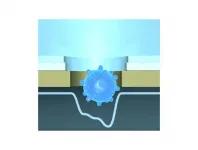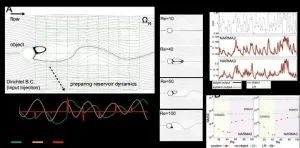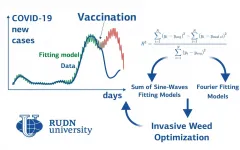INFORMATION:
Hydrophobic copper catalyst to mitigate electrolyte flooding
2021-06-17
(Press-News.org) The electroreduction of carbon dioxide (CO2) to produce value-added multicarbon compounds is an effective way to cut down CO2 emission. However, the low solubility of CO2 largely limits the application of related technology.
Although gas diffusion electrode (GDE) can accelerate the reaction rate, the instability of the catalysts caused by electrolyte flooding hinders further reaction.
Recently, inspired by setaria's hydrophobic leaves, Prof. GAO Minrui's team from University of Science and Technology of China developed Cu catalyst composed of sharp needles which possesses high level of hydrophobicity and stability.
The study was published in Journal of the American Chemical Society.
Nature has never failed to be a source of inspiration for scientists. This time, scientists turned to setaria's needle-like leaves to enhance the hydrophobicity of the catalyst in carbon dioxide reduction reaction (CO2RR).
They mimicked the sharp structures on Cu needles to assemble into hierarchical architectures. Such architectures, effectively preventing itself from being wetted just like the setaria's leaves do, enable electrode-electrolyte interface to trap more CO2 as well as help construct robust gas-liquid-solid three-phase boundary that mitigates flooding.
Compared with Cu particles, dendrites hold advantages ranging from stability to productivity.
The predominant hydrophobicity owing to its hierarchical structure doesn't fade appreciably after 10 min of electrochemical operation. Under even more harsh circumstances, like under a constant current density of 300 mA cm-2 for 10 h, the selectivity of the catalyst roughly remains the same with slight loss.
The hierarchical Cu electrode will trap CO2 once they reach the electrode surface, quite similar to the setaria, making mass transfer and accumulation of CO2 possible in practical use.
Furthermore, the selectivity of hierarchical Cu catalyst outstands Cu particles. Cu dendrites can generate the target product, C2+, at a range of applied potentials between -0.53 and -0.68V with overwhelmingly more remarkable C2+:C1+ selectivity of 15.4 at -0.68V over Cu particles.
"The bioinspired hierarchical Cu catalyst effectively mitigates electrolyte flooding by its remarkable hydrophobicity and largely enhances the productivity of CO2RR," said Prof. GAO.
ELSE PRESS RELEASES FROM THIS DATE:
Heat spells doom for Aussie marsupials
2021-06-17
When animals are hot, they eat less. This potentially fatal phenomenon has been largely overlooked in wild animals, explain researchers from The Australian National University (ANU).
According to lead author Dr Kara Youngentob, it means climate change could be contributing to more deaths among Australia's iconic marsupials, like the greater glider, than previously thought.
"Hot weather puts all animals off their food. Humans can deal with it fairly well; we usually have plenty of fat reserves and lots of different ...
'Unshackled' palm-destroying beetles could soon invade Australia
2021-06-17
A destructive pest beetle is edging closer to Australia as biological controls fail, destroying home gardens, plantations and biodiversity as they surge through nearby Pacific islands.
University of Queensland researcher Dr Kayvan Etebari has been studying how palm-loving coconut rhinoceros beetles have been accelerating their invasion.
"We thought we'd outsmarted them," Dr Etebari said.
"In the 1970s, scientists from Australia and elsewhere found that coconut rhinoceros beetles could be controlled with a beetle virus from Malaysia.
"This virus stopped the beetle in its tracks and, for the last 50 years or so, it more-or-less stayed put ...
After the big storm: How to supply emergency power
2021-06-17
As demand for electricity rises and climate change brings more frequent and extreme storms, residents in rural and suburban communities must have access to the minimal electricity they need to survive a large, long-duration (LLD) power outage.
A new study in the journal Risk Analysis compared strategies for providing emergency power to residents in two hypothetical New England communities during such an event. The results suggest that cooperative strategies like sharing a higher capacity generator among multiple homes cost 10 to 40 times less than if each household used its own generator.
"Our findings provide impetus for utilities, regulators, ...
Passing the COVID test in just five minutes
2021-06-17
Osaka, Japan - A team of scientists headed by SANKEN (The Institute of Scientific and Industrial Research) at Osaka University demonstrated that single virus particles passing through a nanopore could be accurately identified using machine learning. The test platform they created was so sensitive that the coronaviruses responsible for the common cold, SARS, MERS, and COVID could be distinguished from each other. This work may lead to rapid, portable, and accurate screening tests for COVID and other viral diseases.
The global coronavirus pandemic has revealed the ...
Vortex, the key to information processing capability: Virtual physical reservoir computing
2021-06-17
[Background]
In recent years, physical reservoir computing*1), one of the new information processing technologies, has attracted much attention. This is a physical implementation version of reservoir computing, which is a learning method derived from recurrent neural network (RNN)*2) theory. It implements computation by regarding the physical system as a huge RNN, outsourcing the main operations to the dynamics of the physical system that forms the physical reservoir. It has the advantage of obtaining optimization instantaneously with limited computational resources by adjusting linear and static readout weightings between the output and a physical reservoir without requiring optimization of the weightings by back propagation. However, since the information processing capability depends ...
Close-up look at brain uptake of omega-3
2021-06-17
SINGAPORE, 17 June 2021 - New details on the structure and function of a transport protein could help researchers develop drugs for neurological diseases that are better able to cross the blood-brain barrier. The findings were published in the journal Nature by researchers at Columbia University Vagelos College of Physicians and Surgeons, Duke-NUS Medical School, Weill Cornell Medicine and colleagues.
Omega-3 fatty acids, like docosahexaenoic acid (DHA), are important for brain and eye development. They are derived mainly from dietary sources and converted ...
Bronze Age Scandinavia's trading networks for copper settled
2021-06-17
New research presents over 300 new analyses of bronze objects, raising the total number to 550 in 'the archaeological fingerprint project'. This is roughly two thirds of the entire metal inventory of the early Bronze Age in southern Scandinavia. For the first time, it was possible to map the trade networks for metals and to identify changes in the supply routes, coinciding with other socio-economic changes detectable in the rich metal-dependent societies of Bronze Age southern Scandinavia.
The magnificent Bronze Age in southern Scandinavia rose from copper traded from the British Isles and Slovakia 4000 years ago. 500 ...
Sensitive and specific detecting biomarker of radiation-resistant nasopharyngeal carcinoma
2021-06-17
In a paper published in NANO, a team of researchers from Jiangnan University, China have prepared a convenient sensing platform which can detect microRNA-205 (MiR-205) with high sensitivity and excellent selectivity using TpTta-COF nanosheet and fluorescent oligonucleotide probes.
Nasopharyngeal carcinoma (NPC) is a kind of malignant cancer derived from the epithelial cells, which shows an apparent regional aggregation with a high prevalence in Southern China and Southeast Asia. With the ongoing improvement of radiotherapy technology, the therapeutic effect of NPC patients has been increased significantly. However, the easy recurrence and metastasis still cause the poor prognosis of NPC patients. Many researches indicated that ...
RUDN mathematician builds a COVID-19 spread model -- it shows how vaccination affects pandemic
2021-06-17
RUDN University mathematicians built a model of COVID-19 spreading based on two regression models. The mathematicians divided the countries into three groups, depending on the spreading rate and on the climatic conditions, and found a suitable mathematical approximation for each of them. Based on the model, the mathematicians predicted the subsequent waves. The forecast was accurate in countries where mass vaccination was not introduced. The results are published in Mathematics.
The epidemy spreading rate within the country depends, among other things, on the climatic ...
State of the art and future directions in the clinical application of HR-pQCT in adults
2021-06-17
In recent years, significant progress has been made towards the use of high-resolution peripheral computed tomography (HR-pQCT) imaging in research, and new potential for applications in the clinic have emerged, particularly with the advent of second generation devices.
A newly published state-of-the-art publication on the use and future directions of HR-PQCT provides a concise overview of current clinical applications as well as valuable guidance on the interpretation of results.
Specifically, it gives an overview of:
differences and reference data for HR-pQCT variables by age, sex, body composition and race/ethnicity;
fracture risk prediction using HR-pQCT, specifically in regard to bone microarchitecture in individuals ...





